Comments / Questions (35)
![]() Brigitte Lahm wrote:
Brigitte Lahm wrote:
Danke für die schnelle Antwort. Auf dem Bild ist zwischen dem jeweiligen Rapport von A1 eine Lochreihe, die sich nach oben fortsetzt. Wenn ich bei Reihe 5 19 Maschen habe und bei Reihe 6 nur 17 Maschen, dann verschiebt sich doch das ganze Muster. Muss ich zwischen den einzelnen Rapporten A1 rechte Maschen stricken und wie muss ich die senkrechte Lochreihe beginnen. Ich bin eine sehr geübte Strickerin, aber hier passt etwas nicht oder kapiere ich nichts mehr?
25.10.2019 - 16:33DROPS Design answered:
Liebe Frau Lahm, die kleine Löcher, die man zwischen den Diagrammen im Foto sieht, kommen sicher aus der Abnahmen am Anfang/Ende von den Diagrammen. Bei der 1. Reihe nehmen Sie 2 M zu = 17 M. Bei der 3. Reihe nehmen Sie 2 M zu = 19 M. Das heißt die Maschenanzahl im Diagram ändert je nach der Reihe (deshalb wird es daneben beschrieben), aber die Diagramme werden immer 23 Mal in der Breite wiederholt (= die Maschenanzahl wird dann je nach der Reihe unterschiedlich sein). Viel Spaß beim stricken!
25.10.2019 - 16:39
![]() Brigitte Lahm wrote:
Brigitte Lahm wrote:
Was muss ich zwischen den einzelnen Diagrammen stricken? Auf der Abbildung ist da eine Lochreihe nach oben zu sehen. Und wenn die Maschenzahl nach oben weniger wird, verschiebt sich doch da das Muster.Ich habe nun schon x mal aufgetrennt, weil es einfach nicht stimmt.
25.10.2019 - 11:26DROPS Design answered:
Liebe Frau Lahm, A.1 stricken Sie hintereinander, dh: 2 M kraus rechts, dann 23 x die 15 Maschen in A.1 stricken und mit 2 M kraus rechts enden = 2 + 23x15 - 2 = 349 M. Oder vielleicht mißverstehen ich Ihre Frage?
25.10.2019 - 13:42
![]() Anke wrote:
Anke wrote:
Stimmen die Mengenangaben, 100g Alpaca = 100g Lace? Müssten es nicht eher 250g Alpaca sein?
25.10.2019 - 10:26DROPS Design answered:
Liebe Anke, ja genau, es sollte 250 g DROPS Alpaca sein, Garnmenge wurde korrigiert, danke für den Hinweis. Viel Spaß beim stricken!
04.11.2019 - 11:18
![]() Chougui-Nadia wrote:
Chougui-Nadia wrote:
Ce modèle est tres joli, j'attends l'explication du rang ajourné avec patience merci
21.10.2019 - 22:57DROPS Design answered:
Bonjour Mme Chougui, le rang ajouré est décrit au début des explications, il se compose de 2 rangs (= 1 rang sur l'endroit avec des jetés et des augmentations + 1 rang sur l'envers avec des augmentations comme avant). Bon tricot!
22.10.2019 - 11:04
![]() Ingeborg wrote:
Ingeborg wrote:
Ich verstehe die Lochreihe nicht ganz. Wie erfolgen die Zunahme Ende der Reihe? Ende ich mit einem Umschlag?
13.10.2019 - 17:45DROPS Design answered:
Liebe Ingeborg, bei der Hinreihe (Lochreihe), nehmen Sie wie zuvor bei den 3 ersten Maschen, dann (2 M re zs, 1 Umschlag) wiederholen, bis 3 Maschen übrig sind, diese 3 Maschen stricken Sie wie zuvor = Sie haben 2 Maschen zugenommen. Bei der Rückreihe stricken Sie auch wie zuvor = Sie haben 2 Maschen zugenommen. Nach der ersten Lochreihe (= 2 Reihe), haben Sie 4 Maschen zugenommen und es sind jetzt 33 M auf der Nadel. Viel Spaß beim stricken!
14.10.2019 - 10:41
![]() Lyne wrote:
Lyne wrote:
Je ne comprend pas les informations du point ajouré et comment ont fait les augmentations comme avant. Le rang 1 et 2 comment je doit le lire .Et quand ont commence le tricot monte les 13 mailles et le 1 rang ont commence par 1 jeté et la même chose pour le rang 2 aussi Merci pour vos explications
09.10.2019 - 22:40DROPS Design answered:
Bonjour lyne, le RANG AJOURÉ se compose de 2 rangs: 1 rang sur l'endroit avec des jetés (en augmentant comme avant) et 1 rang sur l'envers (en augmentant comme avant). Cette vidéo montre (pour un autre modèle) comment tricoter les premiers rangs jusqu'à ce qu'il y ait 29 m. Bon tricot!
10.10.2019 - 09:37
![]() Maria wrote:
Maria wrote:
No entiendo a que se refiere "pliegue". Me lo podría aclarar? Gracias
19.09.2019 - 20:02DROPS Design answered:
Hola Maria. 1 pliegue es una fila que se ve de revés por el lado derecho cuando la trabajamos de derecho por el lado revés.
25.09.2019 - 00:10
![]() Françoise CHAMBION wrote:
Françoise CHAMBION wrote:
Je trouve ce modèle vraiment très joli et très léger. J'attends les explications avec impatience. Très cordialement.
06.09.2019 - 09:00
![]() Maria wrote:
Maria wrote:
Wunderschön! Würde ich gerne nachstricken
26.08.2019 - 23:27
![]() Odile wrote:
Odile wrote:
Ce modèle est très joli, les explications ne sont pas encore pretes ?
16.07.2019 - 17:30
December Dunes#decemberdunesshawl |
||||||||||||||||||||||
 |
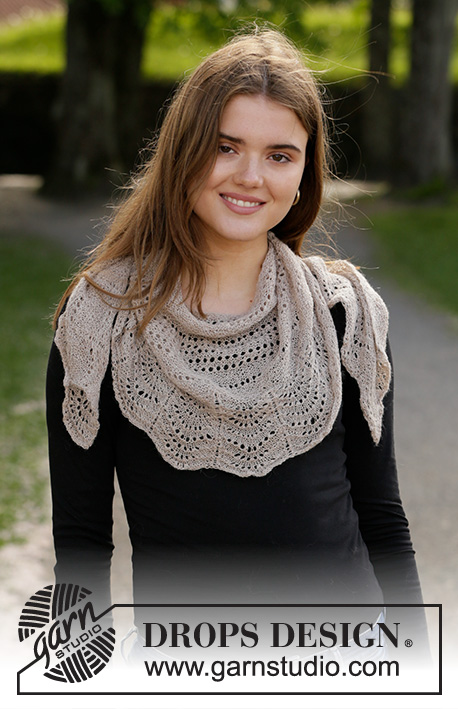 |
|||||||||||||||||||||
Knitted shawl in DROPS Alpaca or DROPS Lace. Piece is knitted top down with garter stitch, eyelet rows and wave pattern.
DROPS 203-17 |
||||||||||||||||||||||
|
---------------------------------------------------------- EXPLANATION FOR THE PATTERN: ---------------------------------------------------------- GARTER STITCH (back and forth): Knit all rows. 2 rows = 1 ridge. EYELET ROW: When working eyelet row, at the beginning of the row as before. Work as follows: ROW 1: Make 1 yarn over, knit 1, 1 yarn over, knit 1. * knit 2 together, 1 yarn over *, work from *-* until 3 stitches remain, and knit 3. ROW 2: Make 1 yarn over, knit 1, 1 yarn over, knit the rest of stitches. INCREASE TIP-1 (evenly): To calculate how to increase evenly, use the total number of stitches on row (e.g. 33 stitches) and divide stitches by number of increases to be done (e.g. 12) = 2.7. In this example increase by making 1 yarn over after alternately every 2nd and 3rd stitch. On next row knit yarn overs twisted to avoid holes. INCREASE TIP-2: If the knitting gauge is incorrect the shawl can have the wrong number of stitches if you need to work more or less rows than stated to get the correct measurements in cm/inches. This error can be corrected on next increase ridge. If you work to tightly, so that e.g. 6 cm = 2⅜" is not 15 ridges as in pattern, but e.g. 16 ridges, there will be 4 or 2 stitches to many on needle (depending on it being before or after INCREASE RIDGE 3). If you work to loose, there will be too few stitches on needle when worked to given measurements in cm/inches. This can be adjusted on next increase ridge, so that number of stitches is the same as number of stitches given when increase ridge is done. PATTERN: See diagram A.1. Diagrams show all rows in pattern seen from the right side. SHAPING: Place the piece in lukewarm water until it is soaking wet. Carefully squeeze out the water - do not twist. Then roll the piece in a towel and squeeze to remove more water. The piece will now only be moist. Place the piece on a carpet or mattress - carefully stretch it out to measurements found under SIZE at the top of pattern and leave to dry. Repeat the process when the piece has been washed. ---------------------------------------------------------- START THE PIECE HERE: ---------------------------------------------------------- SHAWL - SHORT OVERVIEW OF THE PIECE: Worked back and forth on circular needle to make room for all the stitches. Most of the shawl is worked in GARTER STITCH - read explanation above, work the edge at the bottom in wave pattern. SHAWL: Cast on 13 stitches on circular needle size 3.5 mm = US 4 with Alpaca or Lace. Knit 1 row from wrong side. Continue as follows: ROW 1 (= right side): Make 1 yarn over, knit 1, 1 yarn over, knit the rest of stitches (= 2 stitches increased). ROW 2 (= wrong side): Make 1 yarn over, knit 1, 1 yarn over, knit the rest of stitches (= 2 stitches increased). Work in garter stitch and continue to increase 2 stitches at the beginning of every row until 4 ridges have been worked in total from beginning (= 4 stitches increased per ridge) = 29 stitches. Work 1 EYELET ROW - read explanation above (= 4 stitches increased) = 33 stitches. REMEMBER THE KNITTING GAUGE! INCREASE RIDGE 1: Knit 1 row from right side while increasing 12 stitches evenly - read INCREASE TIP-1 in explanation over. Knit next row, knit yarn overs twisted = 45 stitches. Work in garter stitch and continue to increase 2 stitches at the beginning of every row as before until 3 ridges have been worked in total (including increase ridge) from previous eyelet row (= 4 stitches increased per ridge) = 53 stitches. *Work 1 EYELET ROW. Work in garter stitch and continue to increase 2 stitches at the beginning of every row as before until 3 ridges have been worked after eyelet row *, work from *-* 2 times in total (= 4 stitches increased per ridge/eyelet row) = 85 stitches. Work 1 EYELET ROW (= 4 stitches increased) = 89 stitches. INCREASE RIDGE 2: Knit 1 row from right side while increasing 21 stitches evenly. Knit next row, knit yarn overs twisted = 110 stitches. Work in garter stitch and continue to increase 2 stitches at the beginning of every row as before until piece measures 6 cm = 2⅜" from previous eyelet row, equals approx. 15 ridges (including previous increase ridge) (= 4 stitches increased per ridge) = 166 stitches. If the number of stitches deviates, adjust on next increase ridge - READ INCREASE TIP-2 in explanation above. INCREASE RIDGE 3: Knit 1 row from right side while increasing 57 stitches evenly. There should now be 223 stitches on needle. Knit next row, knit yarn overs twisted. NOTE: Now the increase in the side will change from 2 stitches to 1 stitch (on eyelet rows also increase only 1 stitch in the side on each row) - increase and work as follows: ROW 1 (= right side): Knit 1, 1 yarn over and knit the rest of the stitches (= 1 stitch increased). ROW 2 (= wrong side): Knit 1, 1 yarn over and knit the rest of the stitches (= 1 stitch increased). Work in garter stitch and increase in the sides this way until 3 ridges in total have been worked from previous increase ridge (= 2 stitches increased per ridge) = 229 stitches. *Work 1 EYELET ROW - read explanation above. Work in garter stitch and continue to increase 1 stitch at the beginning of every row as before until 2 ridges have been worked in total after eyelet row *, work from *-* 4 times in total (2 stitches increased per ridge/eyelet row) = 253 stitches. Work 1 EYELET ROW (= 2 stitches increased) = 255 stitches. Work in garter stitch and continue to increase 1 stitch at the beginning of every row as before until piece measures 3 cm = 1⅛" from previous eyelet row, equals approx. 7 ridges (= 2 stitches increased per ridge) = 269 stitches. If the number of stitches deviates along the way, adjust on next increase ridge - read INCREASE TIP-2. Work 1 EYELET ROW (= 2 stitches increased) = 271 stitches. INCREASE RIDGE 4: Knit 1 row from right side while increasing 64 stitches evenly. There should now be 335 stitches on needle. Knit next row, knit yarn overs twisted. Work in garter stitch and continue to increase 1 stitch at the beginning of every row as before until piece measures 3 cm = 1⅛" from previous eyelet row, equals approx. 7 ridges (2 stitches increased per ridge) = 349 stitches. Piece measures approx. 25 cm = 9¾" measured on the middle from cast-on edge and down. Now it is important to have the correct number of stitches because of the diagrams. If you need to, you can work 1 more ridge and adjust the number of stitches if the number is incorrect. Work according to diagram A.1 as follows: Work 2 edge stitches in garter stitch, work A.1 (= 15 stitches) until 2 stitches remain on needle (repeat A.1 23 times) and work 2 edge stitches in garter stitch. Work diagram 1 time vertically. BIND-OFF: To avoid a tight bind-off, make yarn overs when binding off by knitting from right side as follows: Make 1 yarn over over the stitches that were yarn overs in pattern, bind off yarn overs as stitches. Make sure to avoid tightening the yarn along the way. If the edge still is tight use a larger needle size for bind-off. Cut and fasten the yarn. When shawl is done, wash and shape if you want - read SHAPING in explanation above. |
||||||||||||||||||||||
Diagram explanations |
||||||||||||||||||||||
|
||||||||||||||||||||||
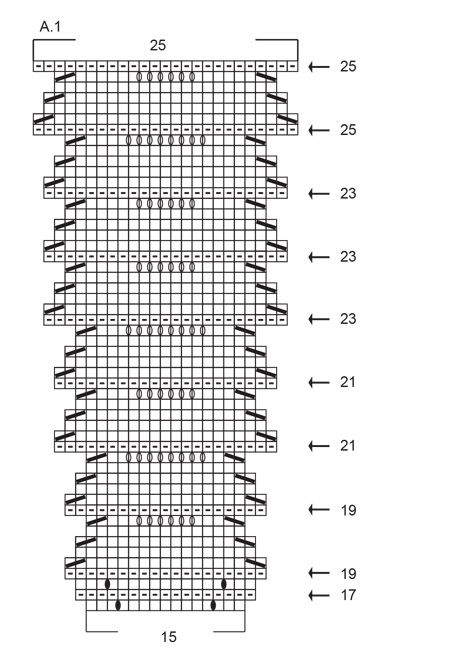 |
||||||||||||||||||||||
Have you finished this pattern?Tag your pictures with #dropspattern #decemberdunesshawl or submit them to the #dropsfan gallery. Do you need help with this pattern?You'll find 19 tutorial videos, a Comments/Questions area and more by visiting the pattern on garnstudio.com. © 1982-2025 DROPS Design A/S. We reserve all rights. This document, including all its sub-sections, has copyrights. Read more about what you can do with our patterns at the bottom of each pattern on our site. |
||||||||||||||||||||||







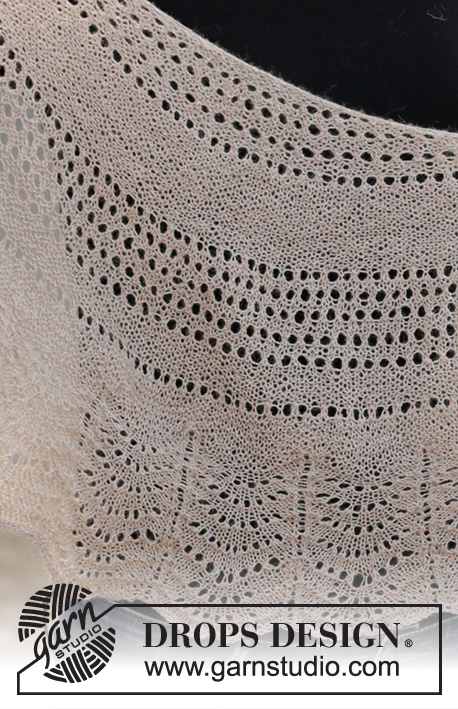

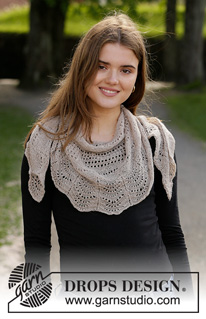
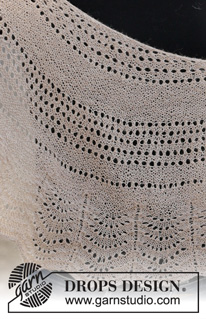









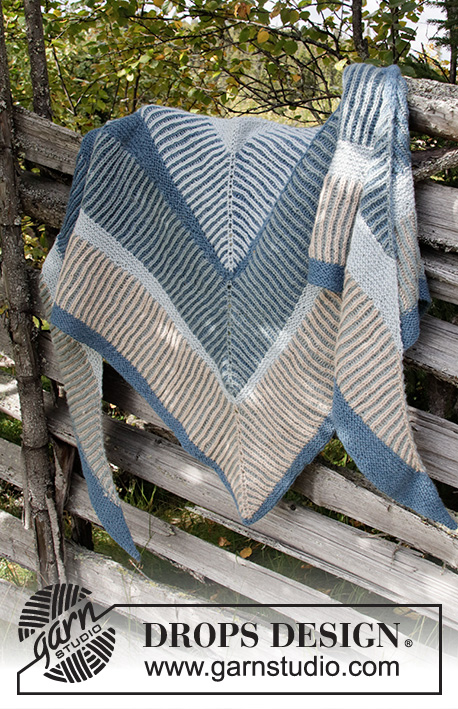












































Post a comment to pattern DROPS 203-17
We would love to hear what you have to say about this pattern!
If you want to leave a question, please make sure you select the correct category in the form below, to speed up the answering process. Required fields are marked *.